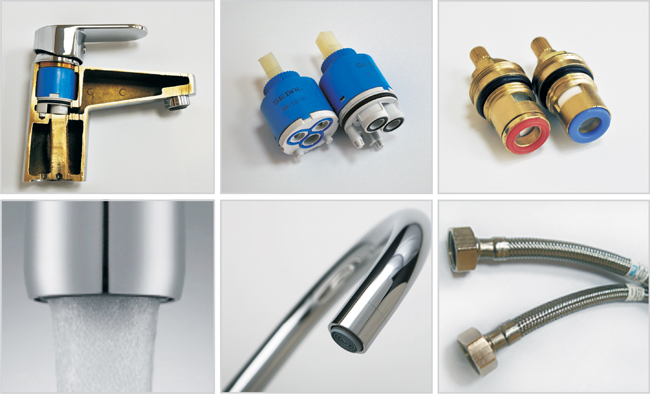Faucet. How do you choose the right quality?
When choosing a faucet, you understand that it’s hard to tell the good from bad among the wealth of available products in the stores today. Things get much simpler when you know what components a good product must consist of, what materials it must be made of, and most importantly – how it should be take care of. Knowing these criteria, you can easily choose a high-quality faucet.
Identifying the quality of the components
Everyone wants to choose a high-quality and reliable faucet that will serve them for years. To do this, pay attention to certain parts of the faucet: the cartridge, aerator, headwork and feed pipes.
Let’s begin by looking at the core of the faucet: the cartridge and headwork. Cartridges are used in single-lever faucets, and a headwork – in dual-lever ones. The most common faucets today use ceramic parts. They are made with a wear-resistant aluminum oxide base. The parts are fired at 1200°C and polished with ultrasound. All this is done to harden the ceramic parts and make them resistant to hydraulic shocks. These cartridges and headworks typically last 25 years on average. Another issue to pay attention to is the manufacturer. European manufacturers make the best quality parts for faucets, have all the necessary quality certificates and perform regular quality assurance procedures. The best known manufacturers are Sedal, Kerox, and Fluhs. These names personify quality and respect.
Water-saving cartridges (so-called eco-cartridges) are becoming increasingly popular of late. These are based on a dual system: with a light pull, you raise the lever to the first position at which water consumption is 10 liters a minute. With a little extra effort and an audible click, you can switch the cartridge into the second position. At this point, water consumption is 20 liters a minute. In both cases, the water pressure is the same; the only difference is in the stream diameter. With the eco-cartridge, you can save up to 50% of your water.
Another water-saving device is the aerator. It helps reduce water consumption by an additional 10% by adding air bubbles into the stream. As a result, the water comes out of the spout in a softer, lighter stream, and is pleasant to touch. Ideally, an aerator should be made of ABS plastic with a silicone or plastic mesh. Then you don’t have to worry about limescale deposits: any residue can be removed with a simple swipe of your fingers.
Now let’s define the quality criteria for a faucet’s feed pipes. These must be flexible and rust-resistant. Also make sure that feed pipes can withstand water temperatures of up to 90°C and a working pressure of 8-10 bar. The feed pipe coupling and nut must be made of brass, with steel outer braiding and a non-toxic natural rubber inner hose.
What a faucet should be made of
A good faucet is always made of brass, which is durable and long-lasting. Brass is a zinc and copper alloy, with at least 59% copper content. The faucet must be plated with chrome, bronze, copper, or sometimes even gold. The most common plating material is chrome-nickel alloy, which forms a reflective silver film that is perfectly suitable for most modern design concepts. Bronze and copper add an interesting golden glow, which harkens back to the atmosphere of an old-time luxurious boudoir. To check the plating quality, look at each detail against the light: surfaces must be perfectly smooth and without flaws. The faucet surface must be level, with even color.
Spout tips are usually made of ABS plastic, which is corrosion-resistant like brass, and can be used in high humidity conditions. Good sprinklers are made of silicone. They are resistant to limescale deposits and can easily be cleaned, while also making the water stream smooth and soft. These materials do not release any harmful chemicals when in contact with water, thus ensuring your safety.
Taking care of the faucet
To keep the faucet in top shape and preserve its original condition, keep it clean at all times. In most cases, all you need to do is to wash the faucet with warm soapy water, then rub it with a dry soft cloth. Remember to never use scouring powder or abrasive cleaning pads on chrome-nickel plated parts!
Use special detergents for respective surfaces. First apply the detergent to a soft sponge, then wipe the faucet. Finally, wash off the detergent with plenty of water. Remember: even special detergents designed for this kind of material must not remain on the surface for too long.
After you’ve removed all the dirt from the faucet, wipe it dry with a dry soft cloth. This removes ugly stains as water droplets dry.
And remember to keep your bathroom clean at all times. Wash soap splashes off the faucet every time you take a shower.
